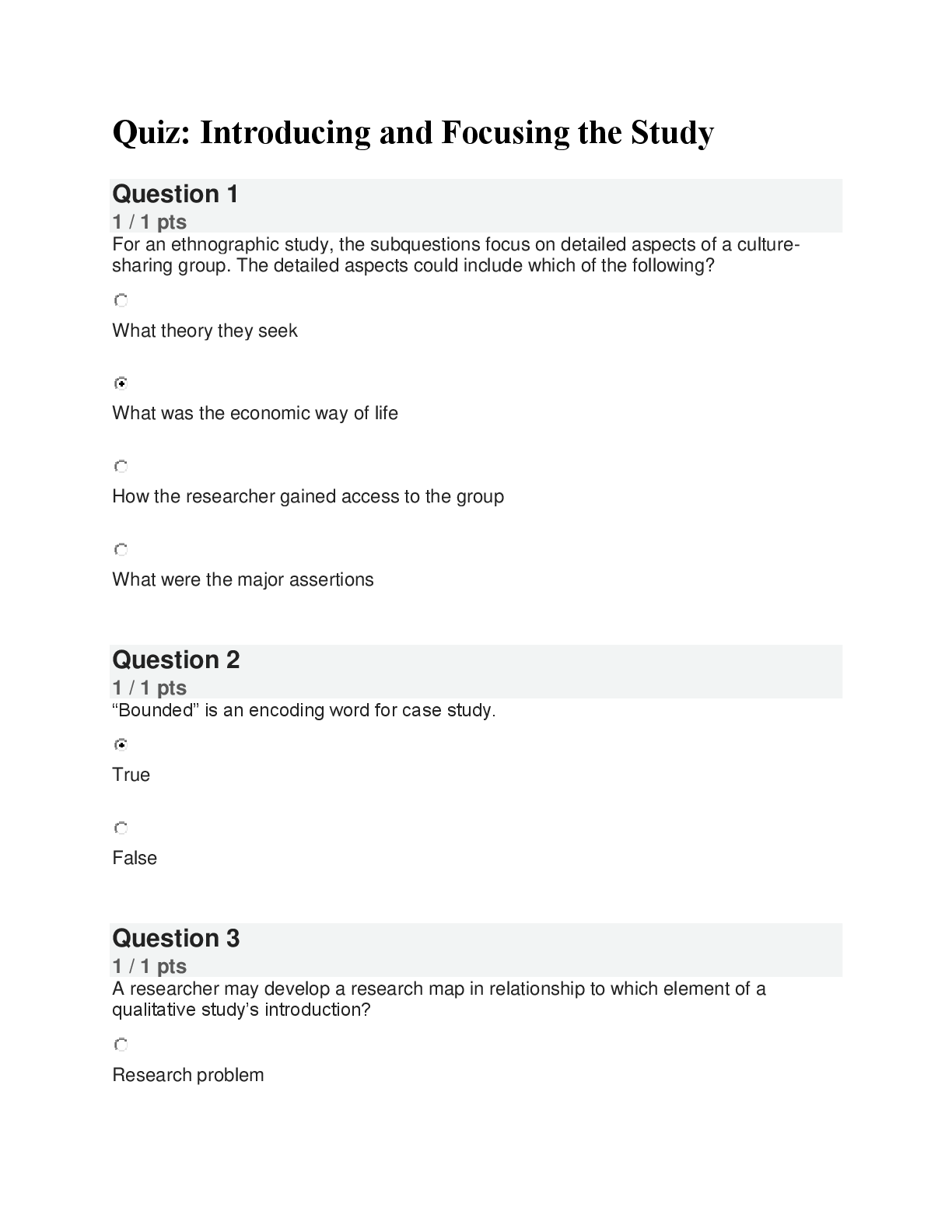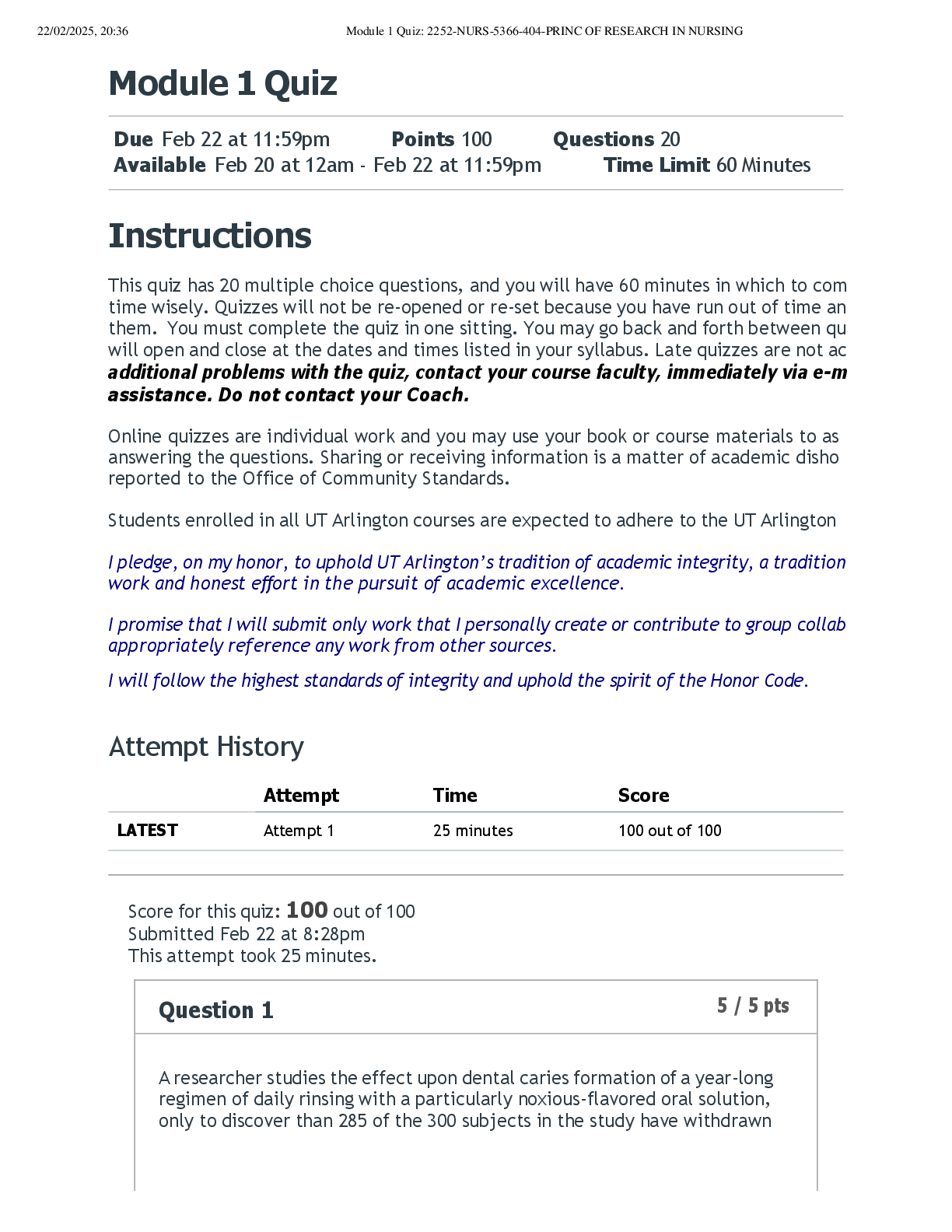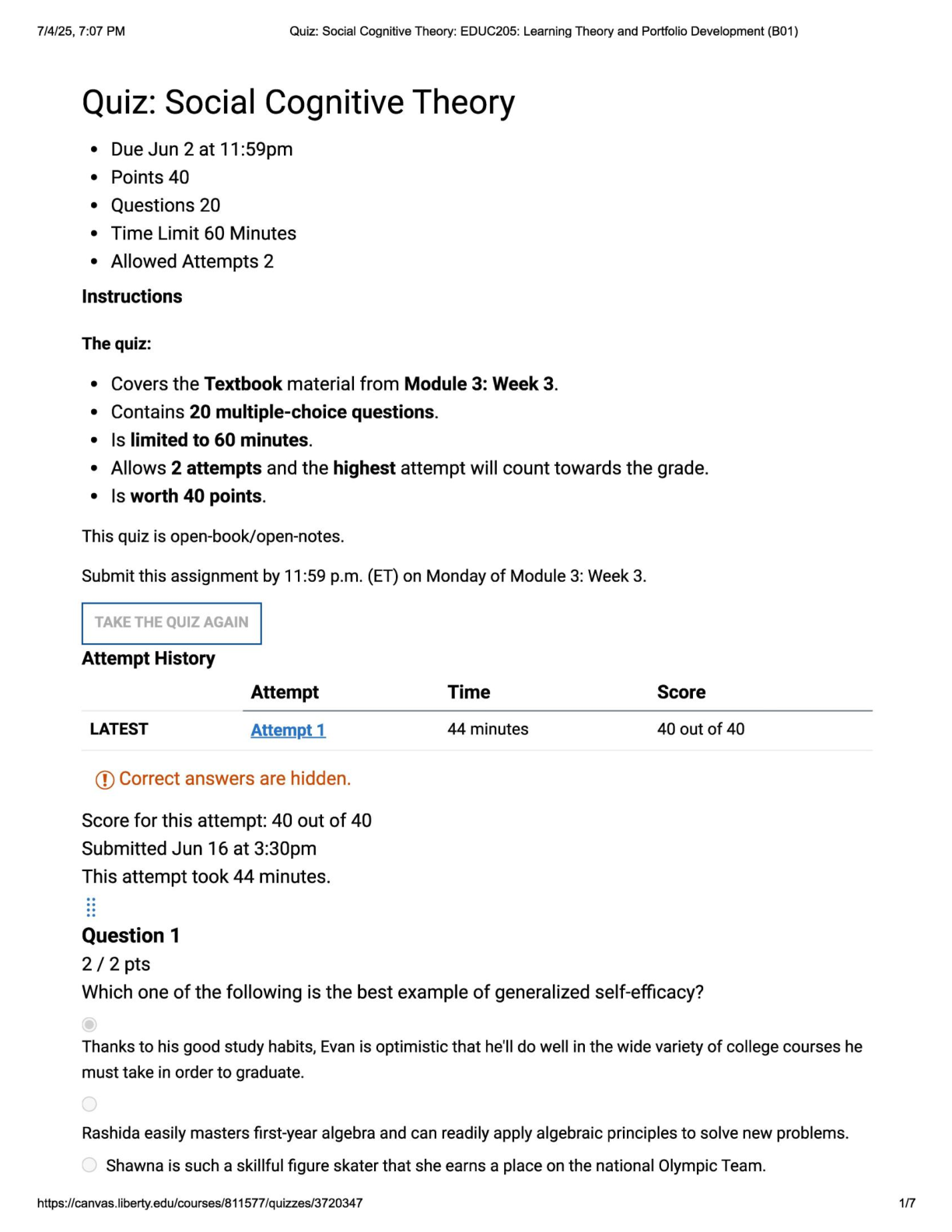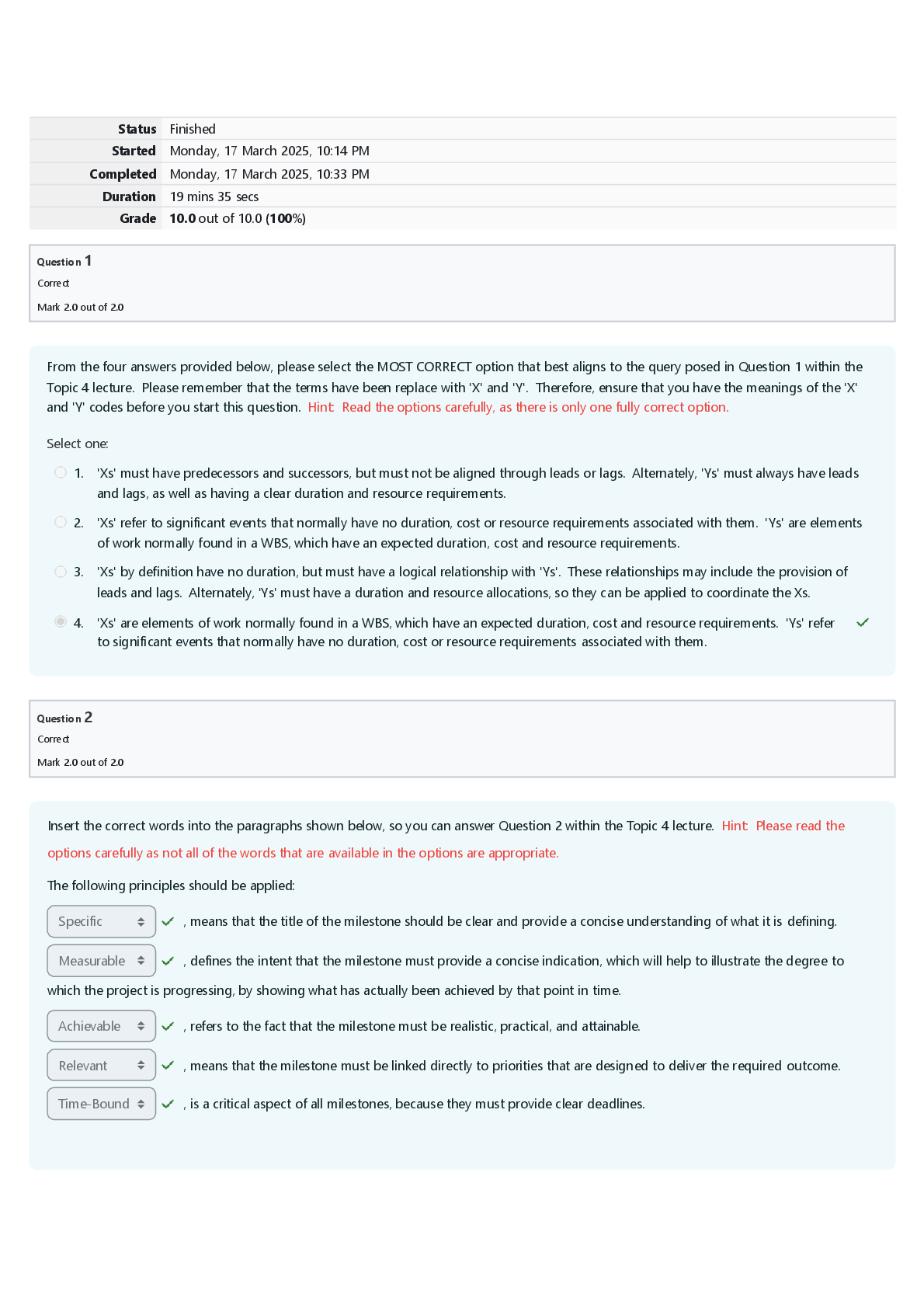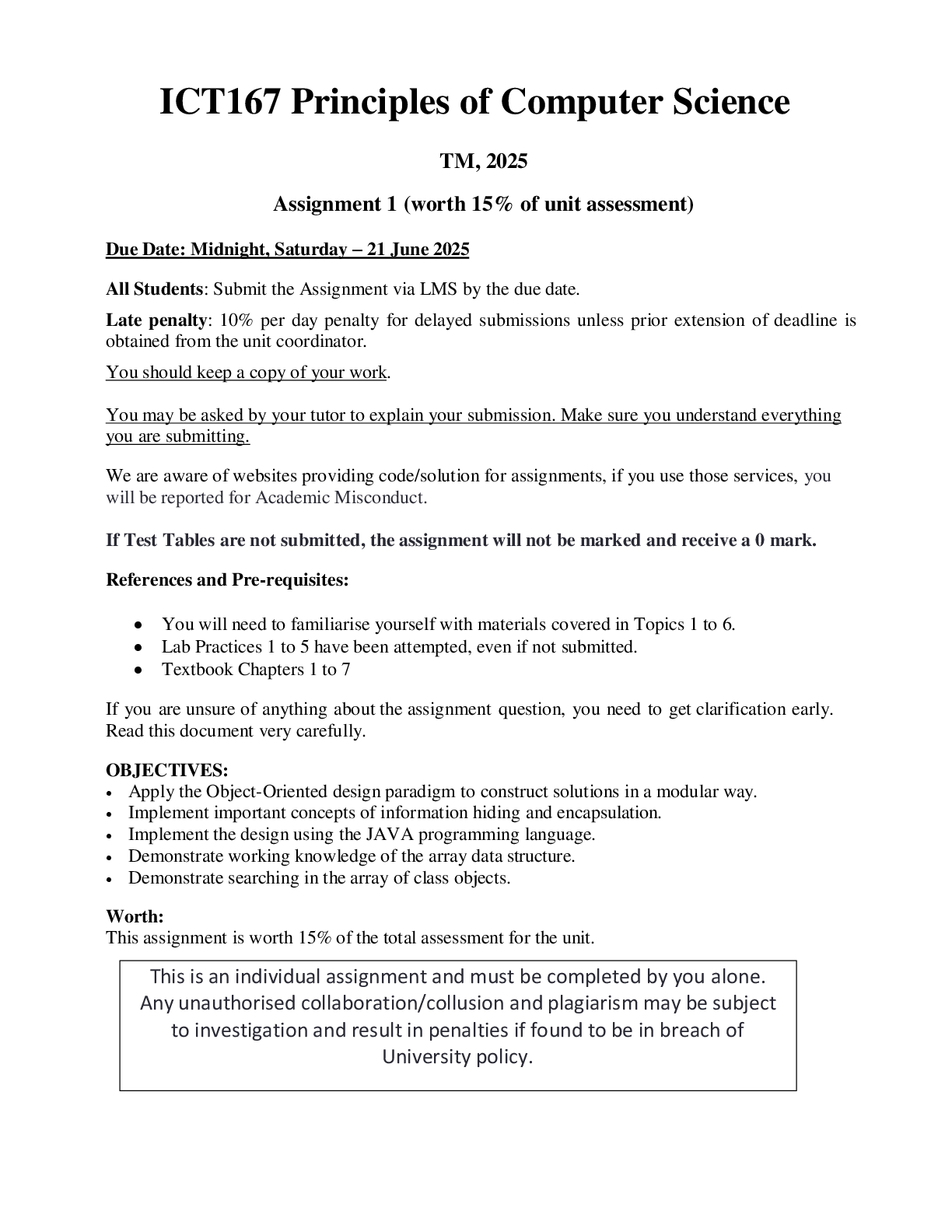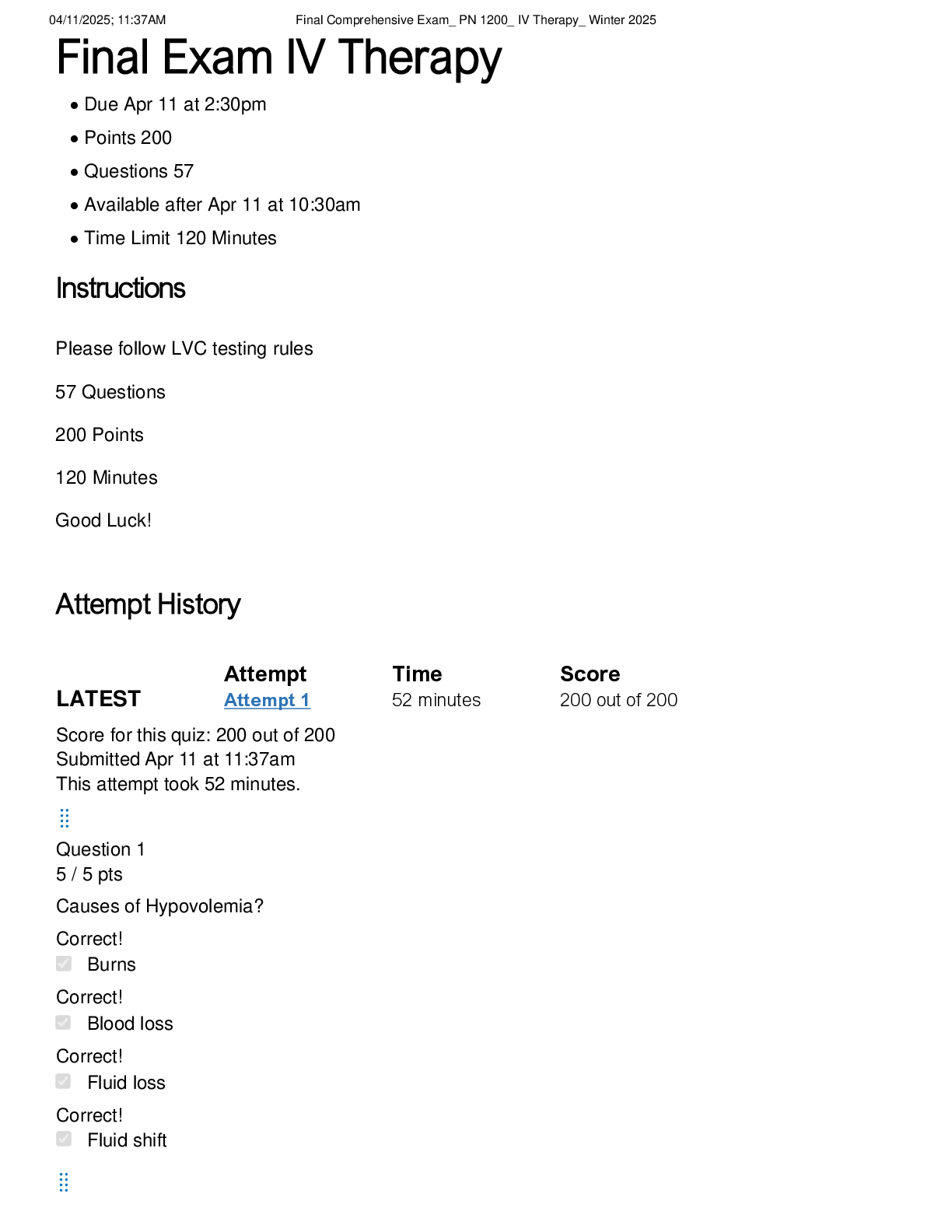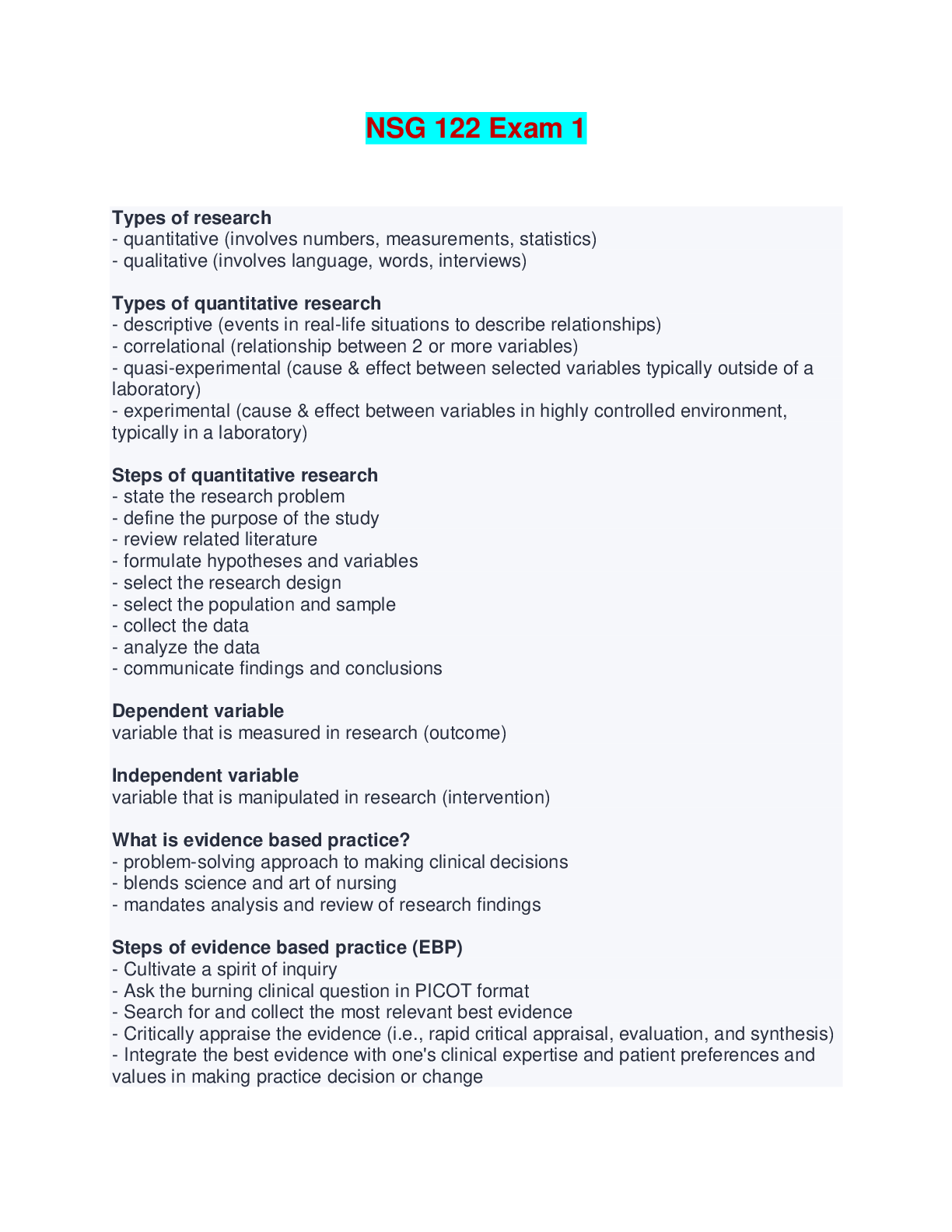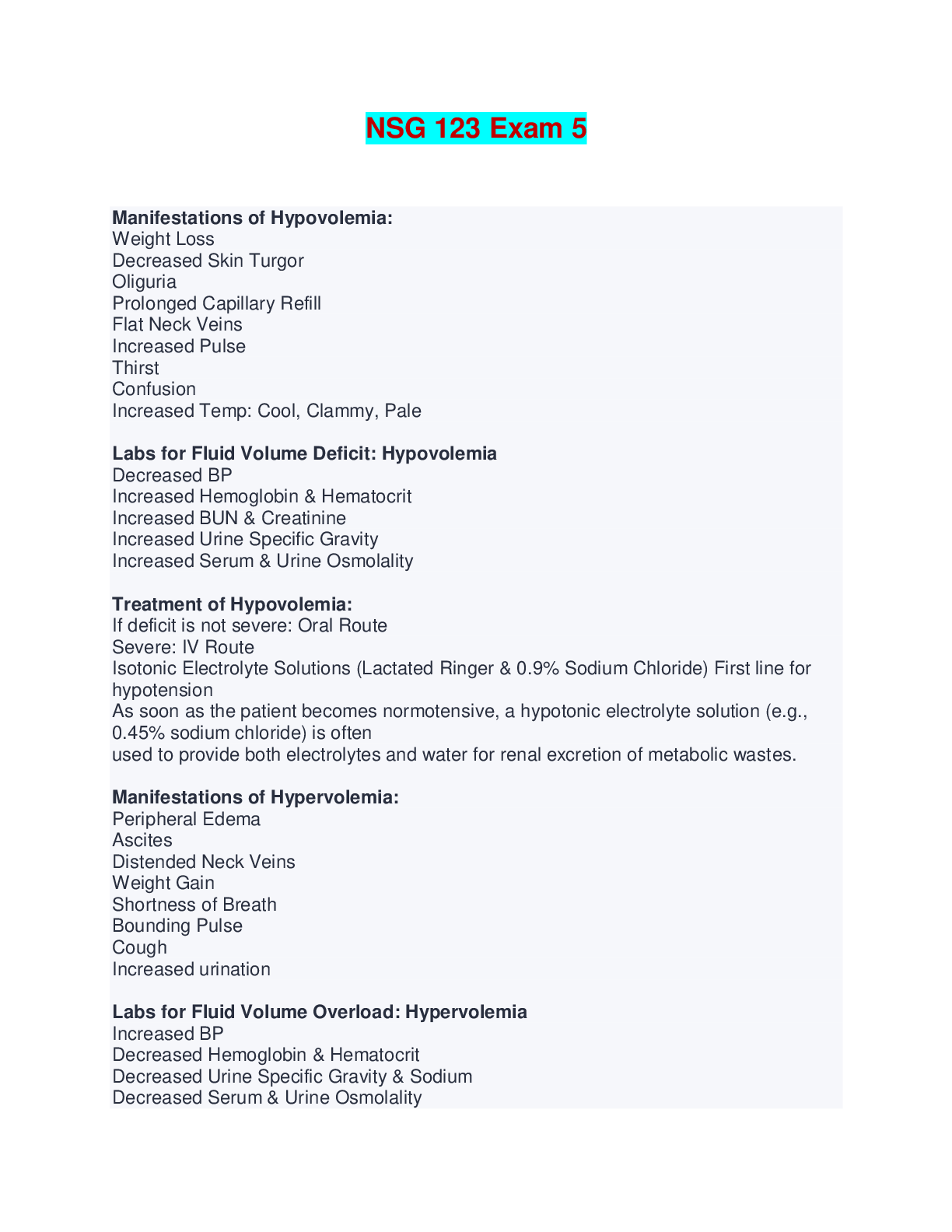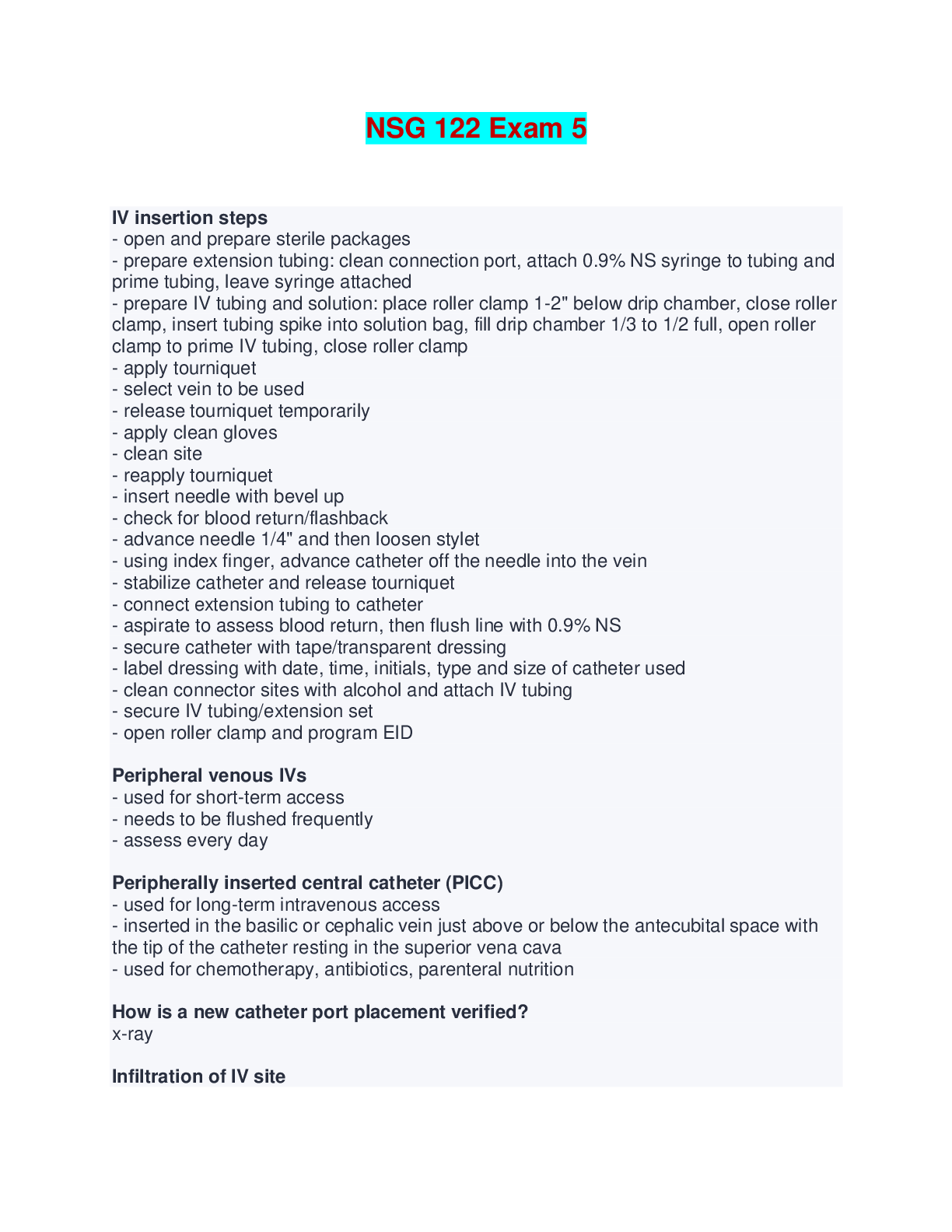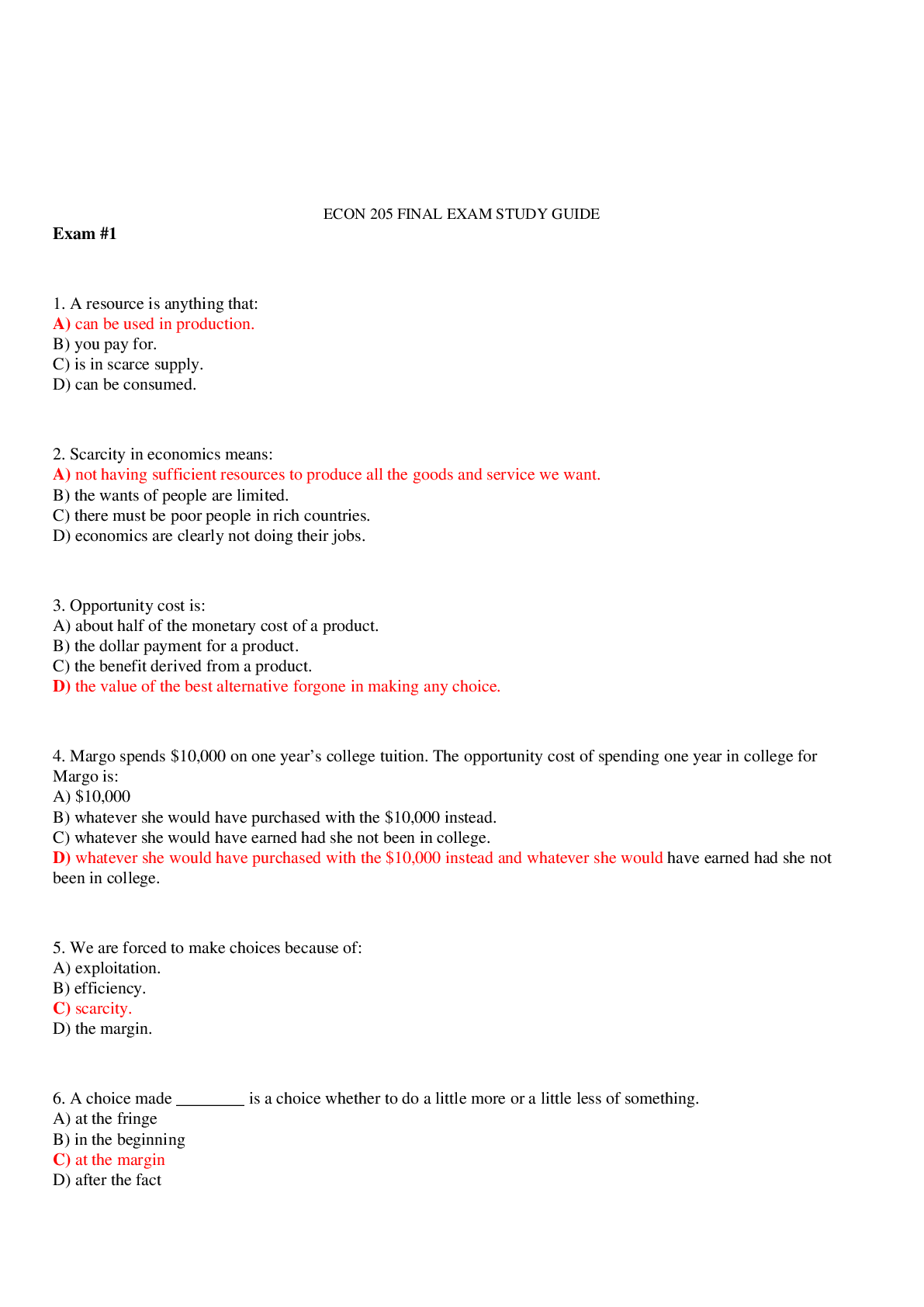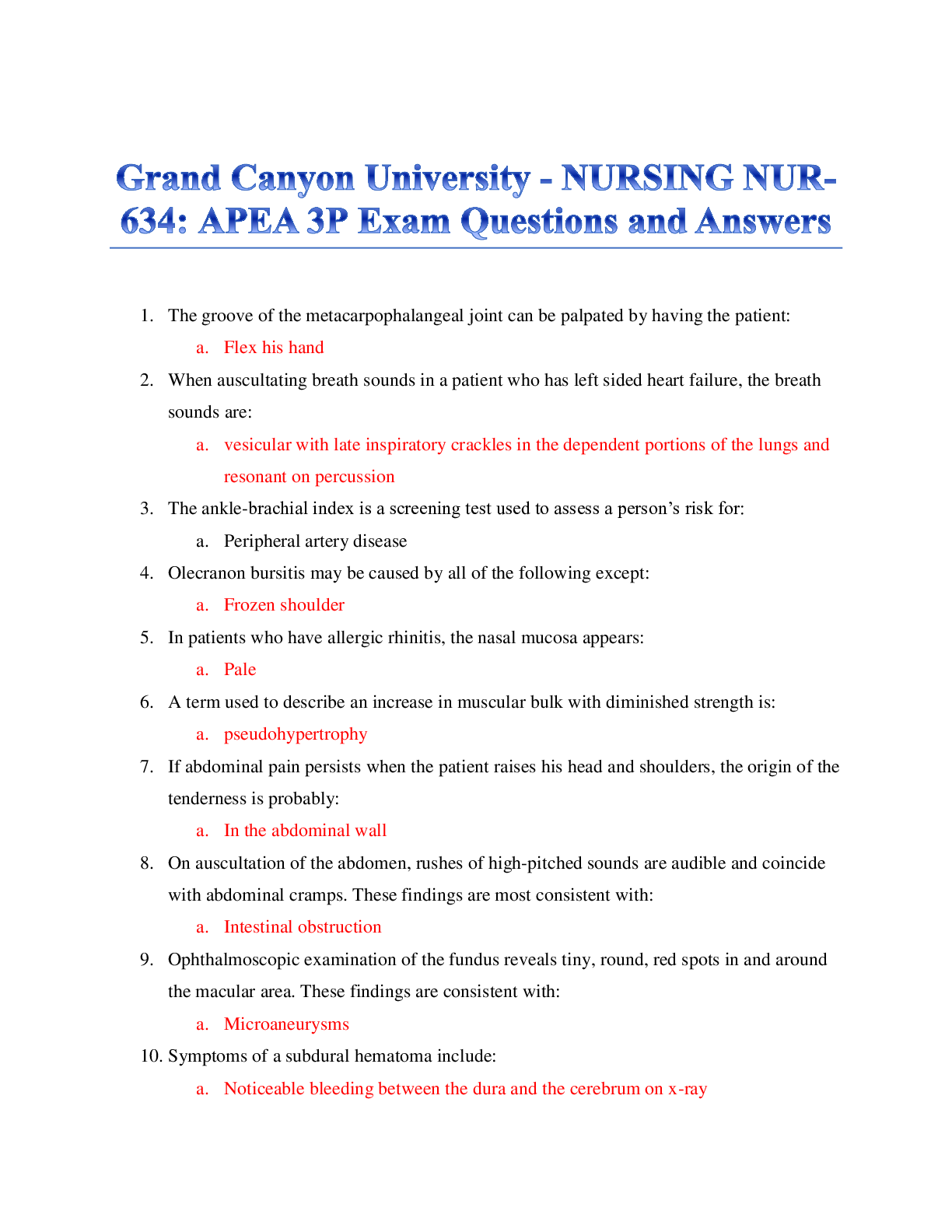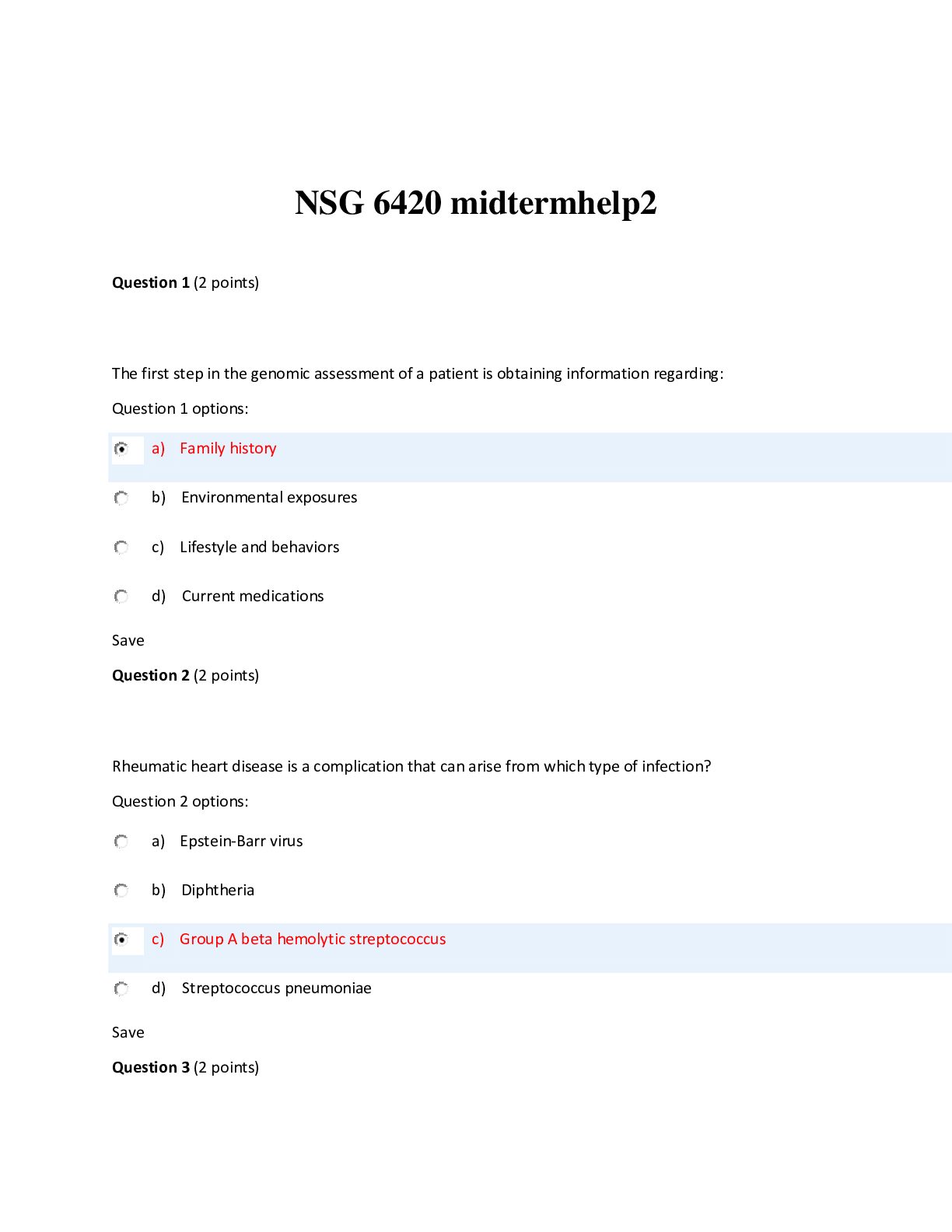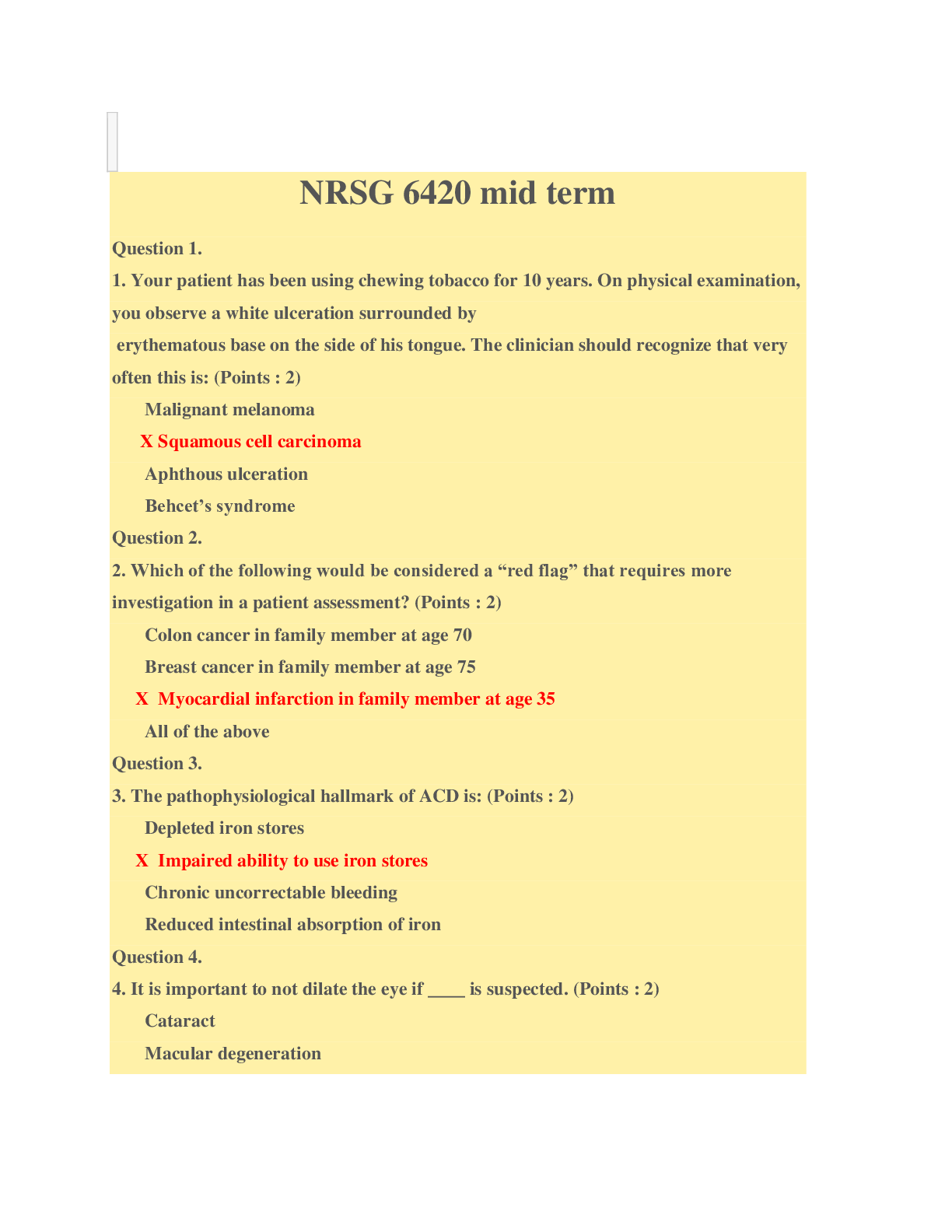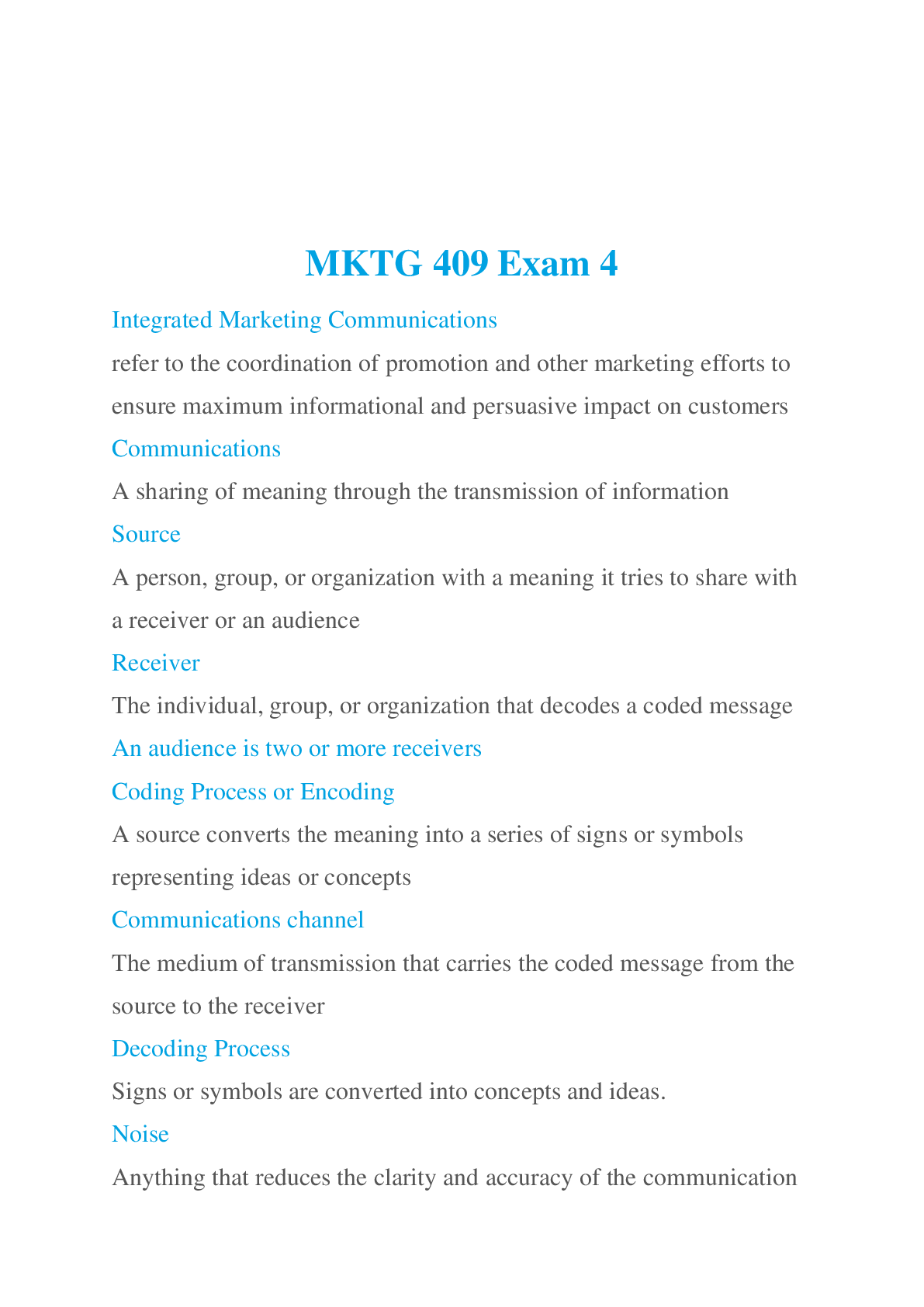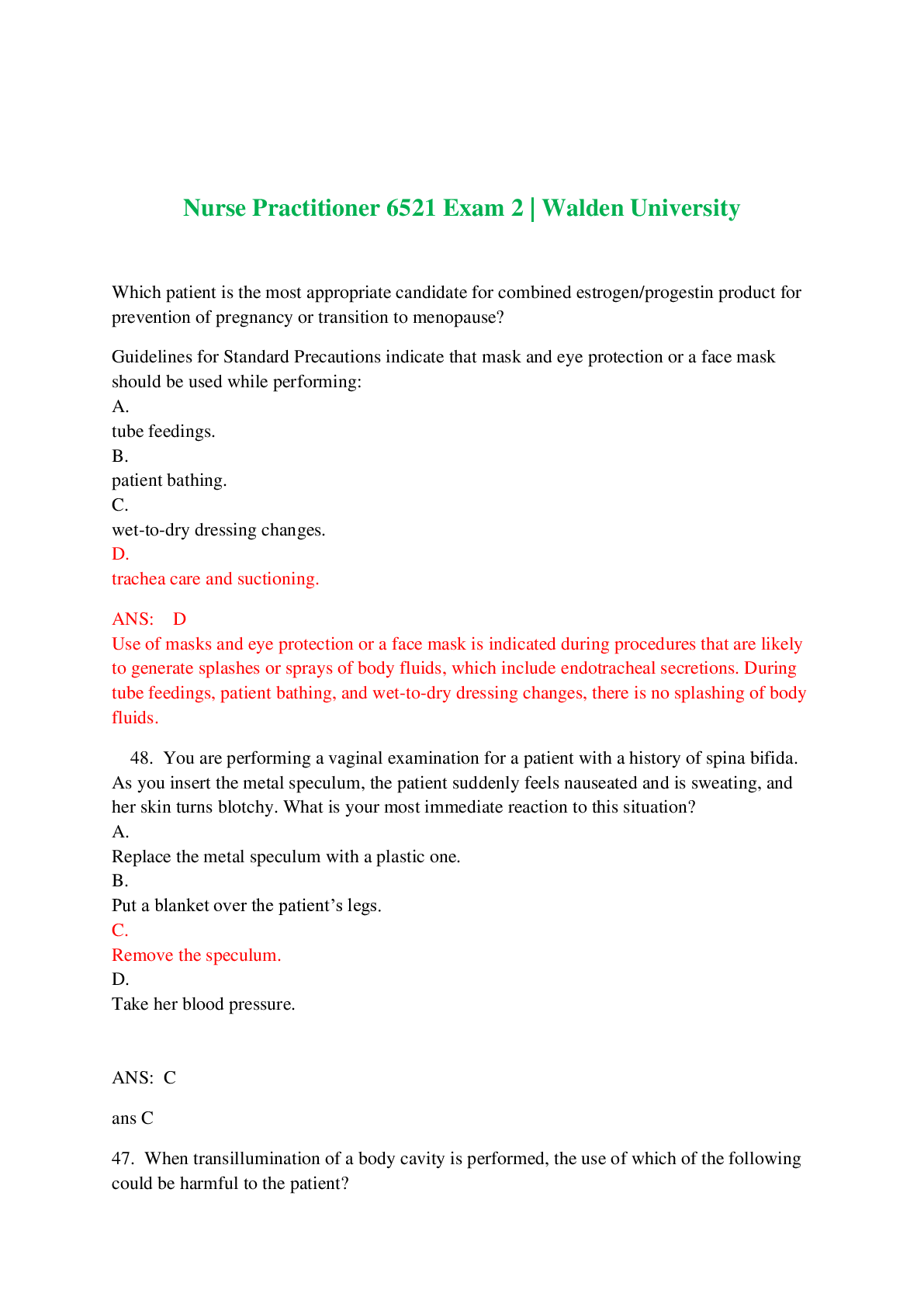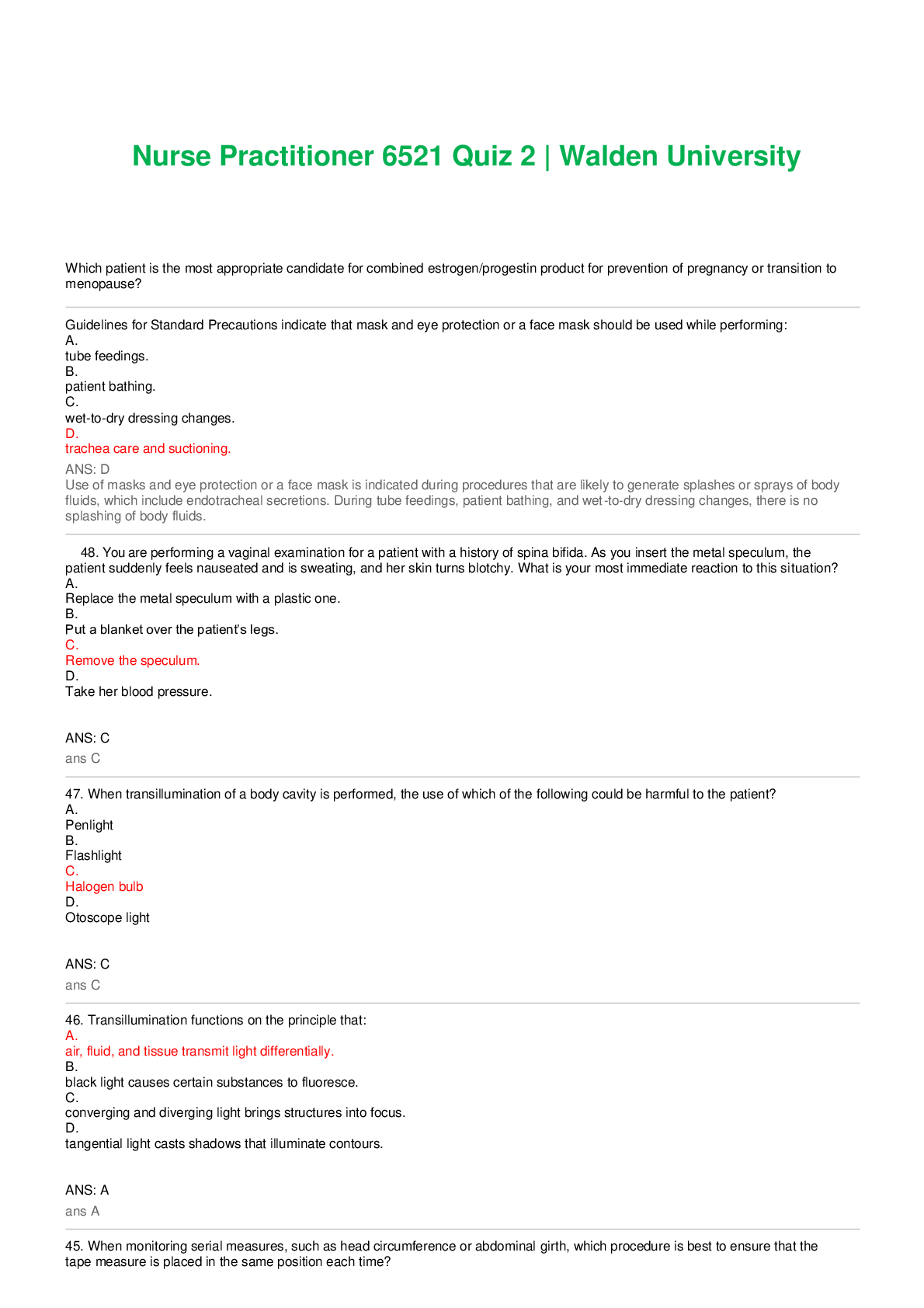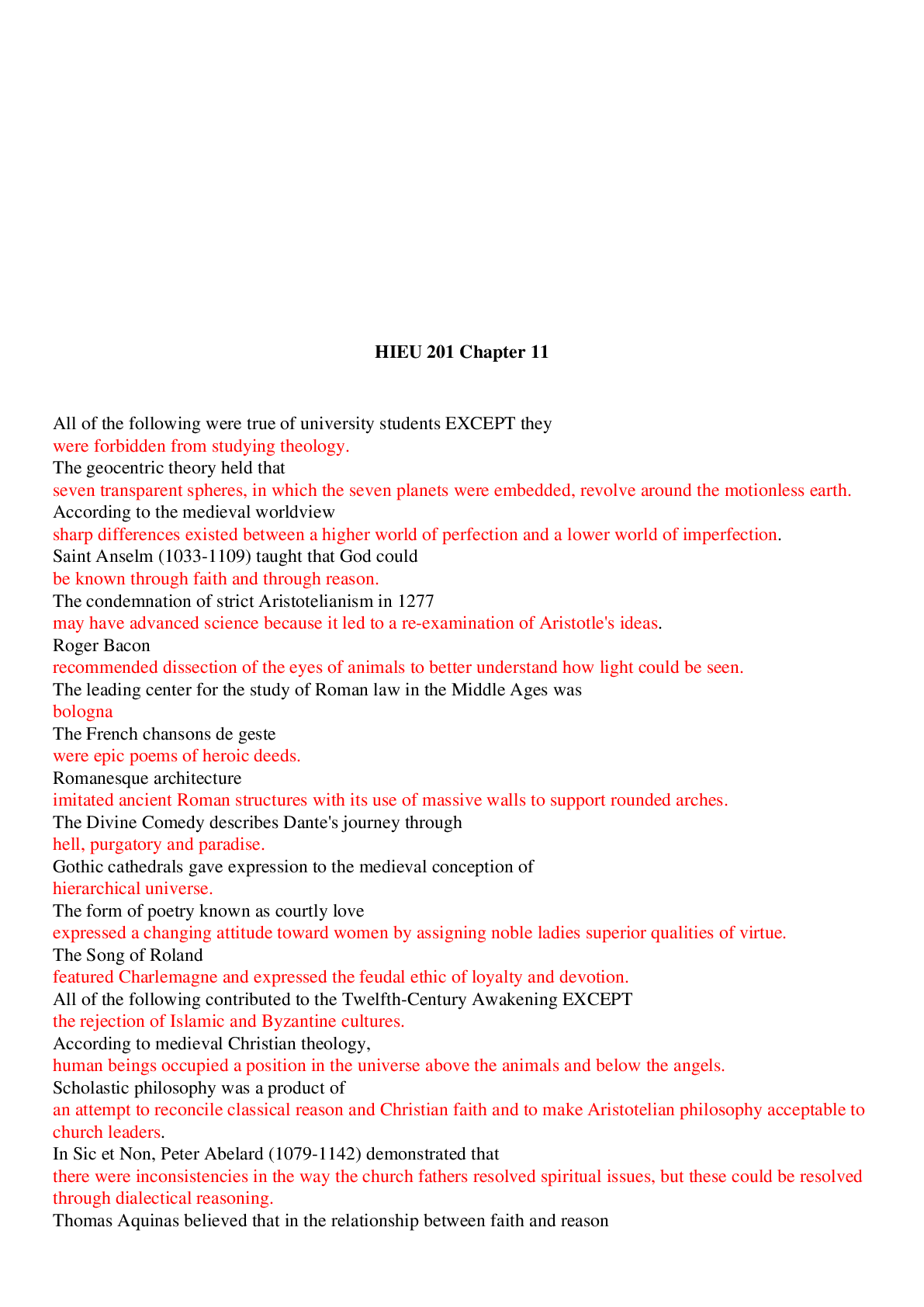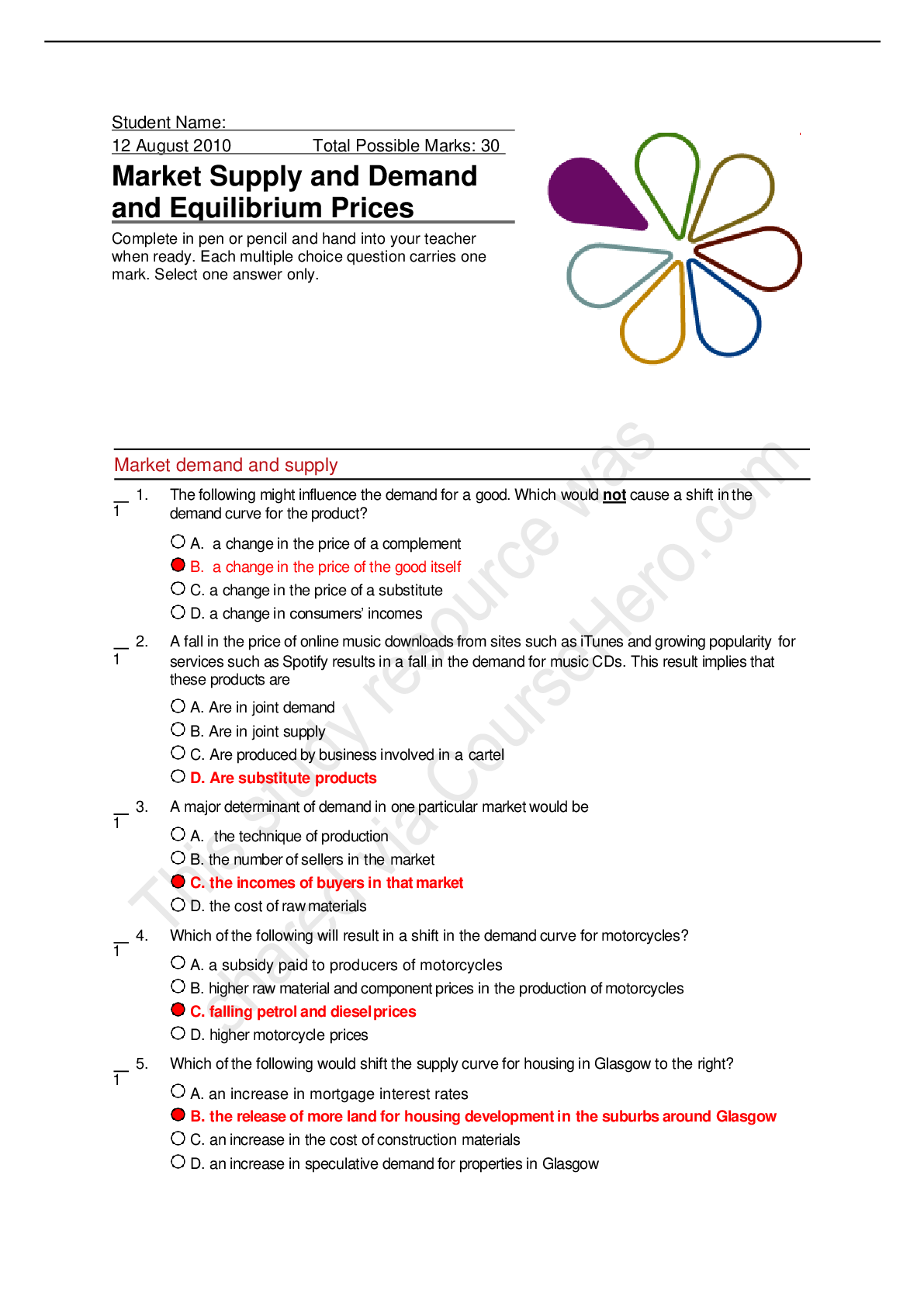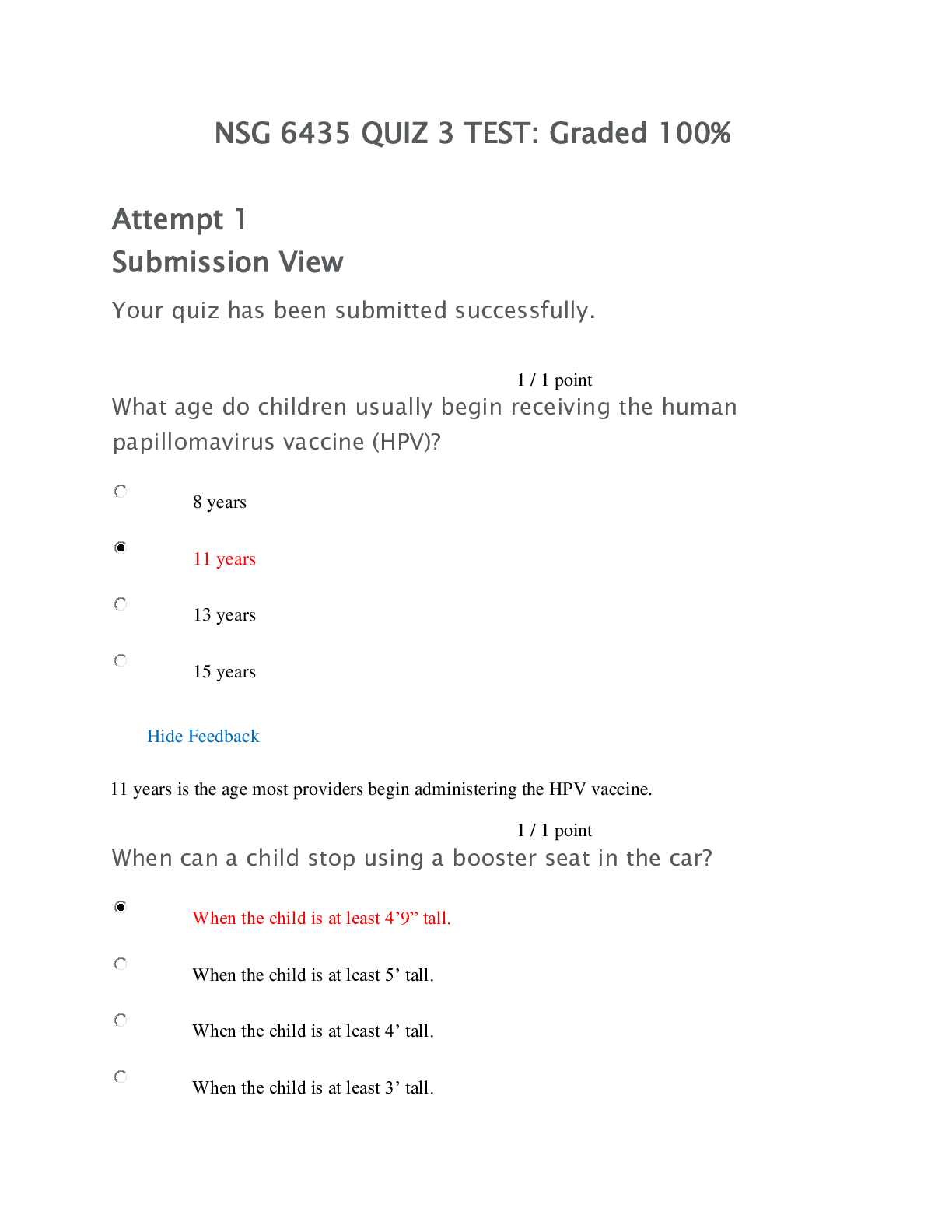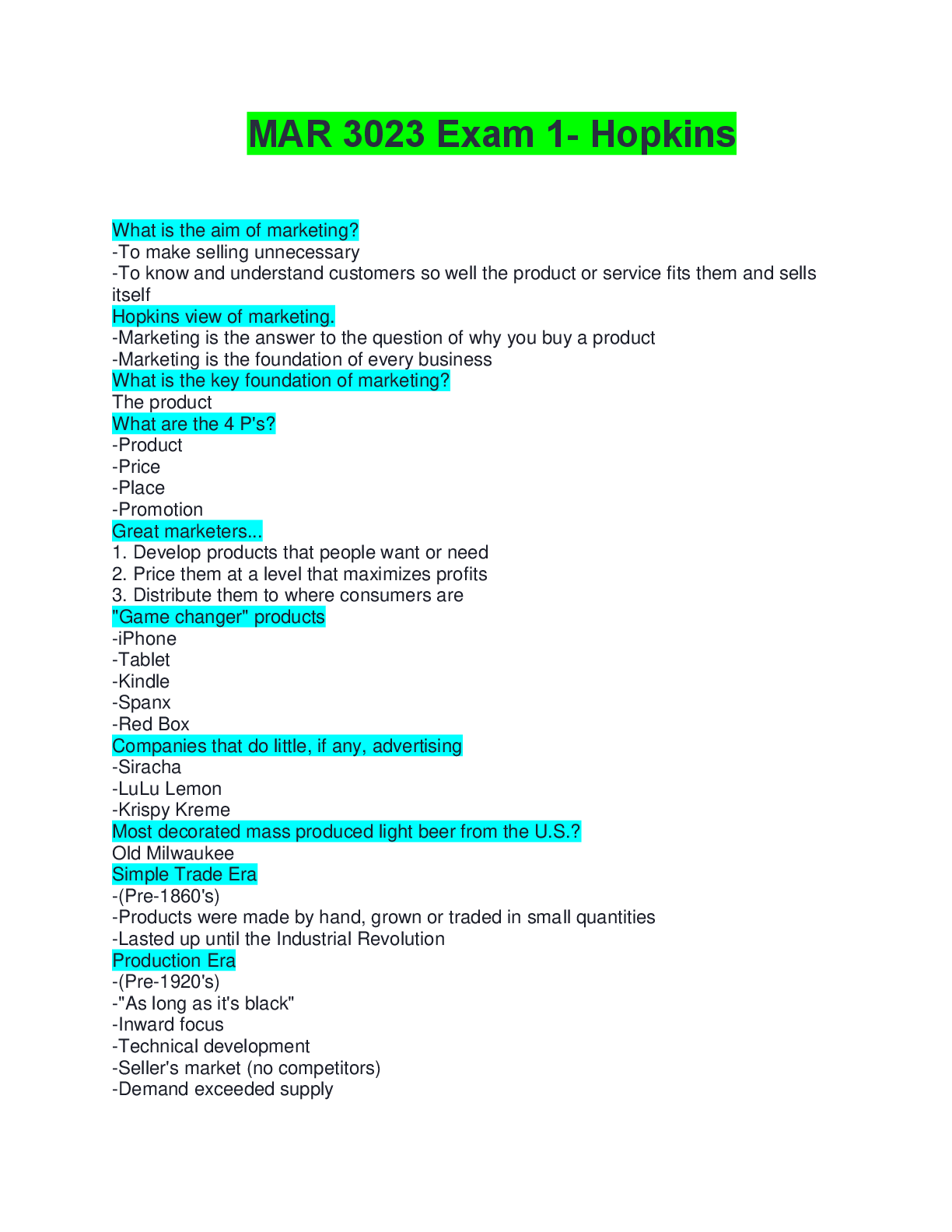c21 CNURSING 295 - Questions and Answers (Complete Solutions)
Document Content and Description Below
N295 ch21 MULTIPLE CHOICE 1. The nurse is percussing the seventh right intercostal space at the midclavicular line over the liver. Which sound should the nurse expect to hear? 2. Which st ... ructure is located in the left lower quadrant of the abdomen? 3. A patient is having difficulty swallowing medications and food. The nurse would document that this patient has: 4. The nurse suspects that a patient has a distended bladder. How should the nurse assess for this condition? 5. The nurse is aware that one change that may occur in the gastrointestinal system of an aging adult is: 6. A 22-year-old man comes to the clinic for an examination after falling off his motorcycle and landing on his left side on the handle bars. The nurse suspects that he may have injured his spleen. Which of these statements is true regarding assessment of the spleen in this situation? 7. A patient’s abdomen is bulging and stretched in appearance. The nurse should describe this finding as: 8. The nurse is describing a scaphoid abdomen. To the horizontal plane, a scaphoid contour of the abdomen depicts a ______ profile. 9. While examining a patient, the nurse observes abdominal pulsations between the xiphoid process and umbilicus. The nurse would suspect that these are: 10. A patient has hypoactive bowel sounds. The nurse knows that a potential cause of hypoactive bowel sounds is: 11. The nurse is watching a new graduate nurse perform auscultation of a patient’s abdomen. Which statement by the new graduate shows a correct understanding of the reason auscultation pre-cedes percussion and palpation of the abdomen? 12. The nurse is listening to bowel sounds. Which of these statements is true of bowel sounds? Bowel sounds: 13. The physician comments that a patient has abdominal borborygmi. The nurse knows that this term refers to: 14. During an abdominal assessment, the nurse would consider which of these findings as normal? 15. The nurse is assessing the abdomen of a pregnant woman who is complaining of having “acid indigestion” all the time. The nurse knows that esophageal reflux during pregnancy can cause: 16. The nurse is performing percussion during an abdominal assessment. Percussion notes heard during the abdominal assessment may include: 17. An older patient has been diagnosed with pernicious anemia. The nurse knows that this condition could be related to: 18. A patient is complaining of a sharp pain along the costovertebral angles. The nurse is aware that this symptom is most often indicative of: 19. A nurse notices that a patient has ascites, which indicates the presence of: 20. The nurse knows that during an abdominal assessment, deep palpation is used to determine: 21. The nurse notices that a patient has had a black, tarry stool and recalls that a possible cause would be: 22. During an abdominal assessment, the nurse elicits tenderness on light palpation in the right lower quadrant. The nurse interprets that this finding could indicate a disorder of which of these struc-tures? 23. The nurse is assessing the abdomen of an older adult. Which statement regarding the older adult and abdominal assessment is true? 24. During an assessment of a newborn infant, the nurse recalls that pyloric stenosis would be exhibited by: 25. The nurse is reviewing the assessment of an aortic aneurysm. Which of these statements is true regarding an aortic aneurysm? 26. During an abdominal assessment, the nurse is unable to hear bowel sounds in a patient’s abdomen. Before reporting this finding as silent bowel sounds, the nurse should listen for at least: 27. A patient is suspected of having inflammation of the gallbladder, or cholecystitis. The nurse should conduct which of these techniques to assess for this condition? 28. Just before going home, a new mother asks the nurse about the infant’s umbilical cord. Which of these statements is correct? 29. Which of these percussion findings would the nurse expect to find in a patient with a large amount of ascites? 30. A 40-year-old man states that his physician told him that he has a hernia. He asks the nurse to explain what a hernia is. Which response by the nurse is appropriate? 31. A 45-year-old man is in the clinic for a physical examination. During the abdominal assessment, the nurse percusses the abdomen and notices an area of dullness above the right costal margin of approximately 11 cm. The nurse should: 32. When palpating the abdomen of a 20-year-old patient, the nurse notices the presence of tenderness in the left upper quadrant with deep palpation. Which of these structures is most like-ly to be involved? 33. The nurse is reviewing statistics for lactose intolerance. In the United States, the incidence of lactose intolerance is higher in adults of which ethnic group? 34. The nurse is assessing a patient for possible peptic ulcer disease. Which condition or history often causes this problem? 35. During reporting, the student nurse hears that a patient has hepatomegaly and recognizes that this term refers to: 36. During an assessment, the nurse notices that a patient’s umbilicus is enlarged and everted. It is positioned midline with no change in skin color. The nurse recognizes that the patient may have which condition? 37. During an abdominal assessment, the nurse tests for a fluid wave. A positive fluid wave test occurs with: 38. The nurse is preparing to examine a patient who has been complaining of right lower quadrant pain. Which technique is correct during the assessment? The nurse should: 39. During a health history, the patient tells the nurse, “I have pain all the time in my stomach. It’s worse 2 hours after I eat, but it gets better if I eat again!” Based on these symptoms, the nurse suspects that the patient has which condition? MULTIPLE RESPONSE 1. The nurse suspects that a patient has appendicitis. Which of these procedures are appropriate for use when assessing for appendicitis or a perforated appendix? Select all that apply. [Show More]
Last updated: 3 years ago
Preview 1 out of 12 pages
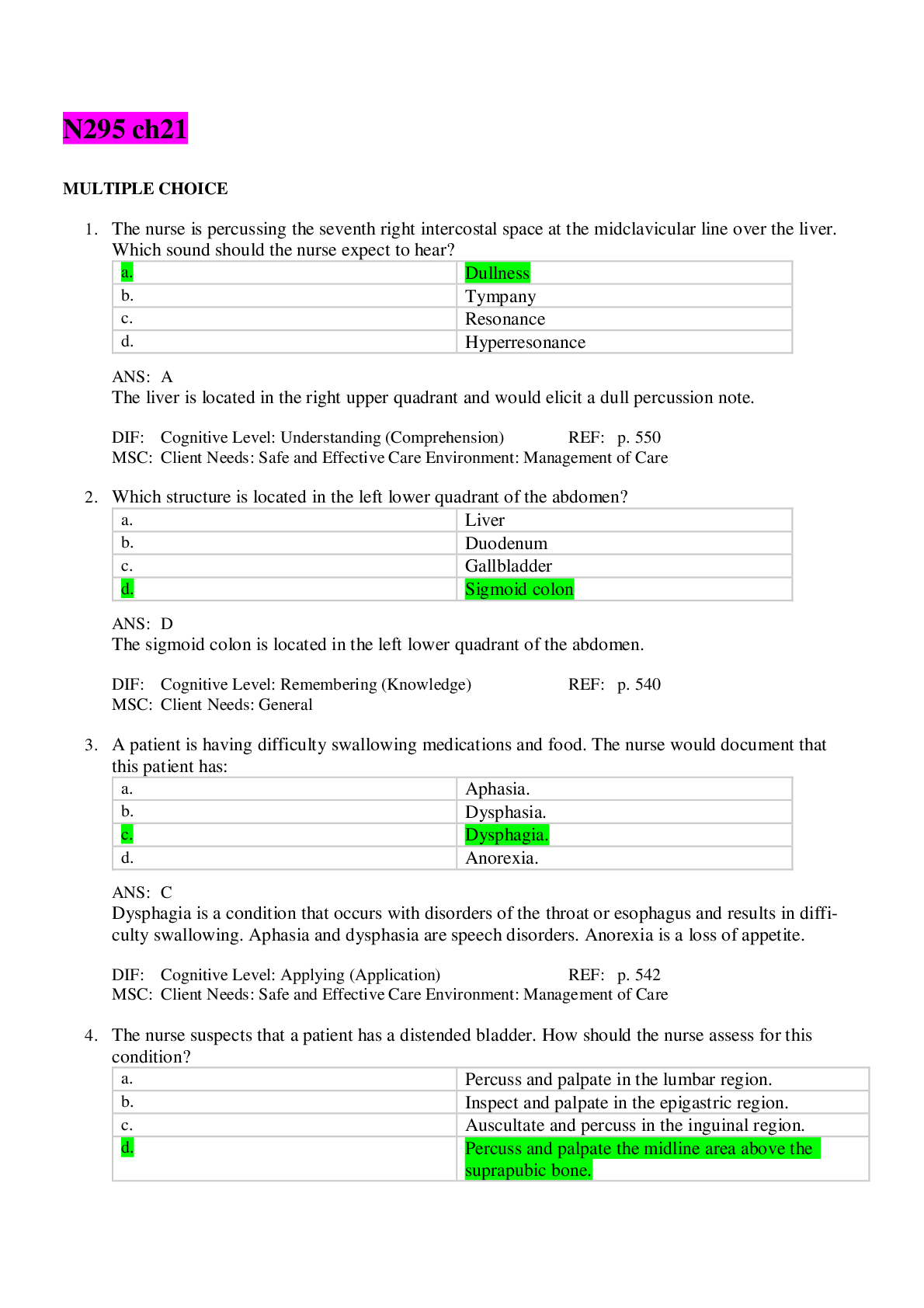
Buy this document to get the full access instantly
Instant Download Access after purchase
Buy NowInstant download
We Accept:

Also available in bundle (1)
Click Below to Access Bundle(s)

CNURSING 295
CHAPTER 23 NEUROLOGIC SYSTEM,CHAPTER 21 ABDOMINAL ASSESSMENT,N295 EXAM 4,N295 EXAM 3,c22,c21,c19,c18,c17,c16,c15,c14,c13,c12,c11,c10,c9,c8,c7,c6,c5,c4,c2,c1
By Ajay25 4 years ago
$75
24
Reviews( 0 )
$15.00
Can't find what you want? Try our AI powered Search
Document information
Connected school, study & course
About the document
Uploaded On
Jan 18, 2021
Number of pages
12
Written in
All
Additional information
This document has been written for:
Uploaded
Jan 18, 2021
Downloads
0
Views
148


